Back in 2020, working from your couch in sweatpants became the norm almost overnight. Fast-forward to 2025, and things look very different. Companies are rolling out formal Return-to-Office (RTO) policies, and they’re not just about bringing people back to their desks; they’re about reshaping what workplace culture really means.
After years of experimenting with remote and hybrid setups, businesses are starting to see RTO as more than a logistical decision. It’s about collaboration, connection, and redefining how teams thrive together. For some, this shift feels like a refreshing return to structure; for others, it’s a tug-of-war between flexibility and tradition. Either way, RTO policies are leaving their mark on everything from employee engagement to how companies attract and keep talent.
Let’s explore how RTO is evolving in 2025 and why the office is becoming less about a physical place and more about the culture it helps create.
The Evolution of RTO Policies (2020-2025)
The way we think about “going to work” has shifted dramatically over the last five years. What started as a global experiment in remote work has become a long-term reimagining of how, where, and why we work. RTO policies didn’t appear overnight. Instead, they’ve evolved with each stage of the workplace journey.
Let’s take a look at how things have unfolded year by year.
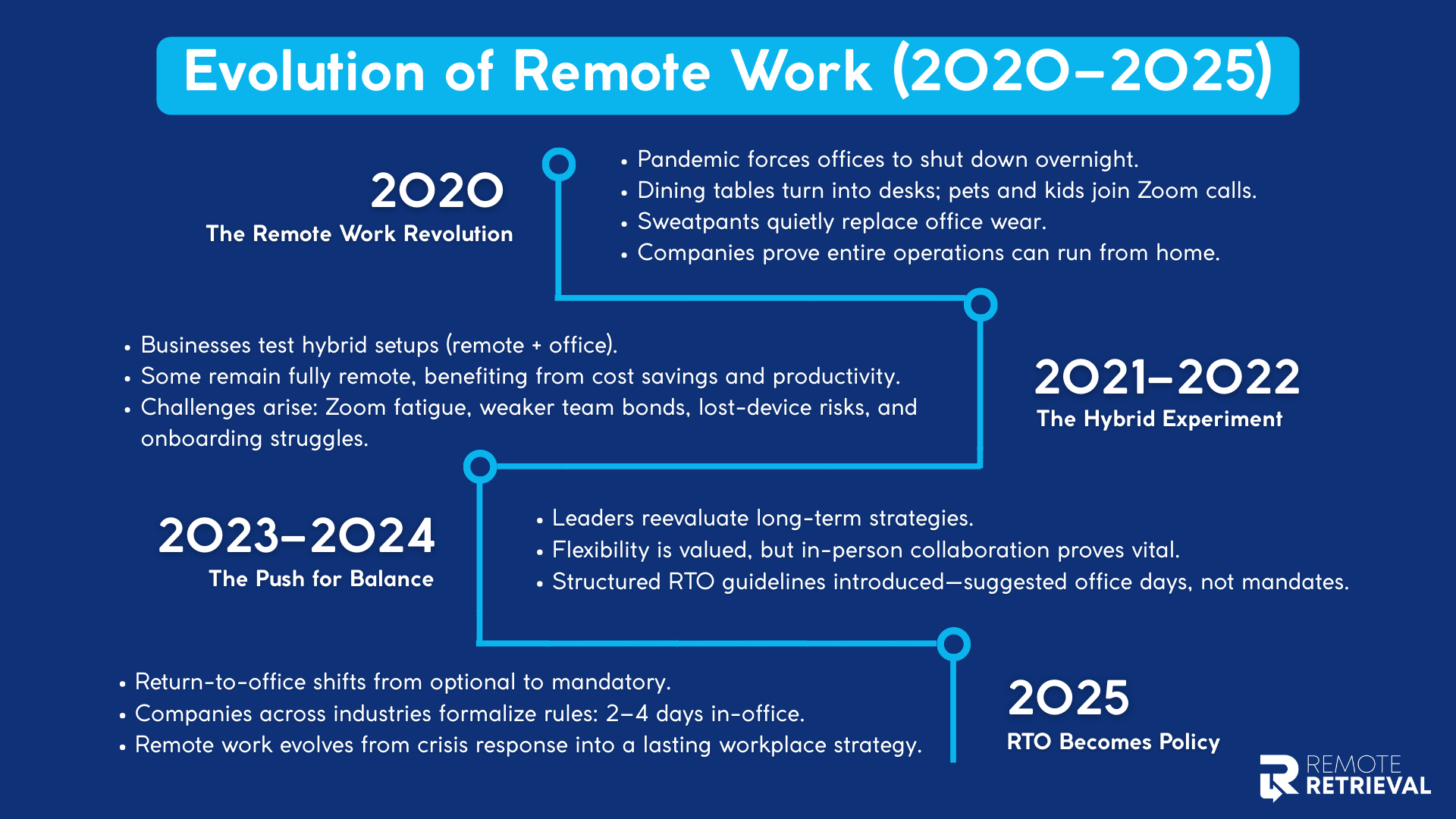
2020: The Remote Work Revolution
When the pandemic hit, offices emptied overnight. Remote work wasn’t a perk anymore; it was a necessity. Dining tables became makeshift desks, kids and pets joined Zoom calls, and sweatpants quietly became the new office attire. Companies adapted quickly, proving that entire businesses could run from home.
2021–2022: The Hybrid Experiment
As restrictions eased, businesses started testing the waters. Some embraced hybrid models, blending remote and in-office work. Others stayed fully remote, enjoying cost savings and surprising productivity boosts. But challenges emerged—managing productivity in remote work, Zoom fatigue, weaker team bonds, cybersecurity risks of lost devices, and tricky onboarding for new hires made it clear that remote work had its limits.
2023–2024: The Push for Balance
Leaders began to rethink long-term strategies. Many realized that while flexibility was valuable, face-to-face collaboration was hard to replace. This period saw the rise of structured RTO guidelines, with companies suggesting (but not yet mandating) certain in-office days.
2025: RTO Becomes Policy
By 2025, the return-to-office conversation shifted from suggestions to official mandates. Tech companies, financial institutions, and even startups formalized RTO rules, often requiring two to four days in-office. What began as a crisis-driven response evolved into a lasting workplace strategy—one that’s now reshaping company culture in big ways.
How RTO Policies Are Shaping Workplace Culture in 2025
Return-to-office policies are changing how teams connect, how leaders manage, and how employees feel about their work. In many ways, RTO has become a cultural reset button, forcing companies to rethink what collaboration, engagement, and balance look like in today’s workplace. Here’s how it’s playing out.
1. Collaboration Feels More Natural Again
After years of virtual meetings, many employees admit there’s something refreshing about solving problems together in person. Quick conversations by the coffee machine, whiteboard brainstorming, or even walking meetings can give rise to creativity that scheduled video calls or remote work tools often couldn’t. These organic interactions spark innovation and rebuild the trust and team chemistry that sometimes got lost in remote work.

Image Source: freepik.com/freepik
Companies in 2025 are reporting smoother cross-department collaboration, faster project turnarounds, and fewer communication hiccups when employees spend at least part of the week working side by side.
2. Employee Engagement is Getting a Boost
An office isn’t only a place to sit and type, it’s also a hub for culture. In 2025, RTO policies will give employees more opportunities to connect with mentors, participate in team-building, and feel part of something bigger than their job title. For younger workers, face-to-face contact with managers and colleagues especially accelerates learning and career growth. For seasoned employees, it rekindles a sense of belonging and shared purpose.

Image Source: freepik.com/freepik
Companies find that employees who show up regularly on flexible but structured schedules report higher engagement, more pride in their workplace, and stronger loyalty to their organizations.
3. Work-Life Balance Looks Different
Of course, bringing back commutes isn’t everyone’s favorite part of RTO. For some, the extra time in traffic or on trains feels like a step backward. But there’s also another angle to consider: the remote work carbon footprint. While staying home reduced travel emissions, it also raised energy use in households worldwide. Now, as employees split time between home and office, companies are rethinking sustainability alongside culture.

Image Source: freepik.com/cookie_studio
Many employees also appreciate the clear boundaries between home and work again. Instead of juggling family responsibilities during Zoom calls, office days bring structure and focus. Recognizing this, companies are pairing RTO with new perks like flexible start times, compressed workweeks, wellness stipends, and on-site mental health resources. The message is clear: while RTO policies bring structure, leaders are also finding creative ways to protect and even improve work-life balance in 2025.
4. Autonomy Meets Structure
One of the biggest cultural challenges of RTO is balancing employee independence with organizational needs. During the remote years, many workers grew used to choosing their hours and working in their own rhythm. In 2025, successful RTO policies don’t completely strip that freedom away—they add structure without killing flexibility.

Image Source: freepik.com/KamranAydinov
For example, companies are setting a minimum in-office days but letting teams choose which ones. Others are offering hybrid schedules tailored to role requirements, ensuring fairness across departments. This mix of accountability and choice helps employees feel respected while still aligning with company goals. The result is a workplace culture where autonomy and structure coexist—making employees more productive without feeling micromanaged.
Employee Reactions: Acceptance vs. Resistance
When RTO policies ramp up, not everyone reacts the same way. For many employees, the shift triggers complicated feelings. Some are excited by the structure and energy of the office, others see it as a threat to the flexibility they’ve come to value. Below are key insights from recent surveys that reveal how divergent employee reactions are.
Survey Data on Employee Preferences in 2025
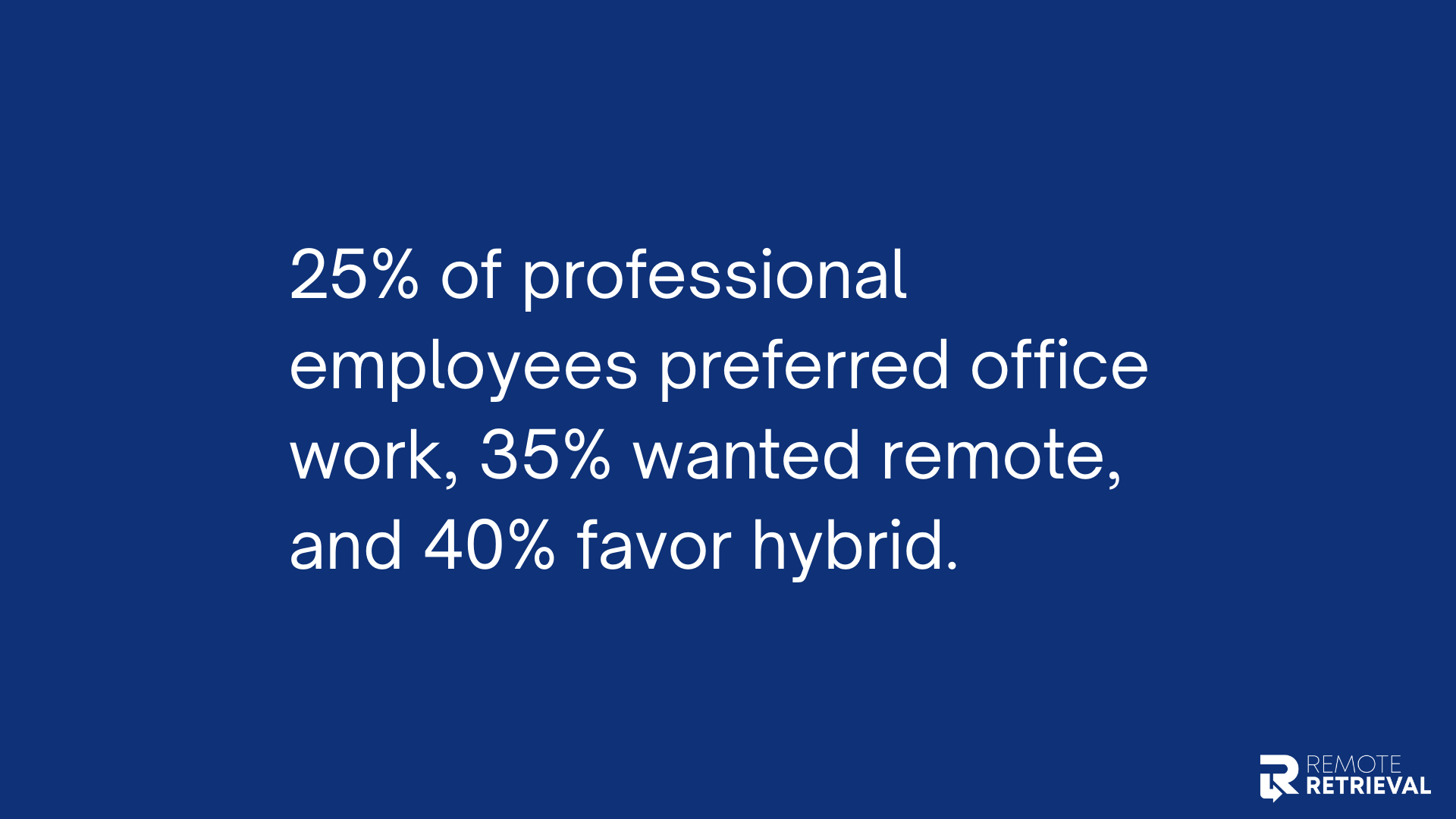
-
A Zoom survey showed about 25% of professional employees preferred office work, 35% wanted remote, and 40% favor hybrid. Among recent graduates, preference for hybrid was even higher—65%.
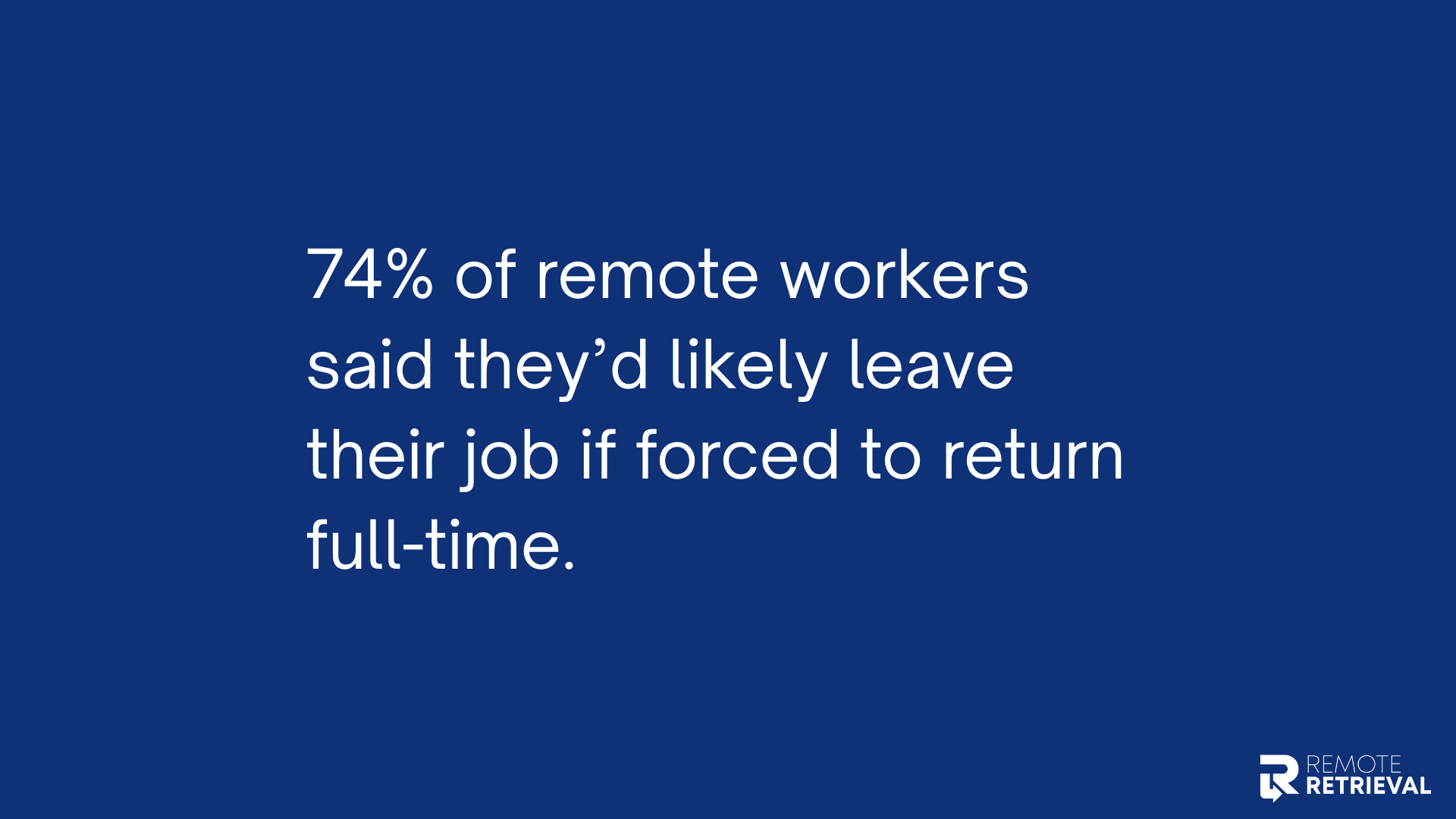
-
In another survey by FTI Consulting, fully remote workers: 74% said they’d likely leave their job if forced to return full-time. Among hybrid workers, that figure was 62%.
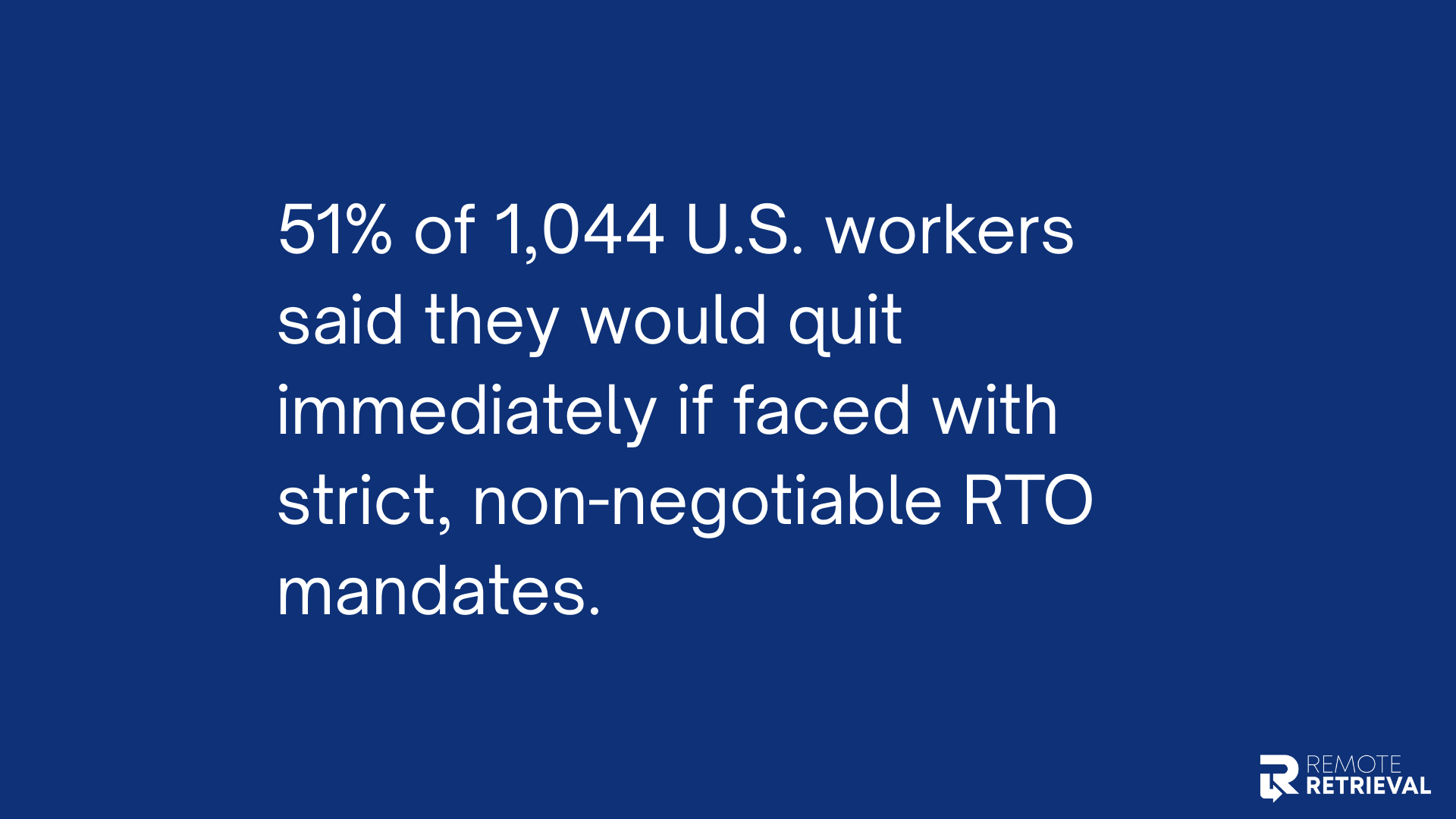
-
According to MyPerfectResume, 51% of 1,044 U.S. workers said they would quit immediately if faced with strict, non-negotiable RTO mandates. Preferences: 45% fully remote, 33% hybrid, and only 22% wanted full-time in-office work.
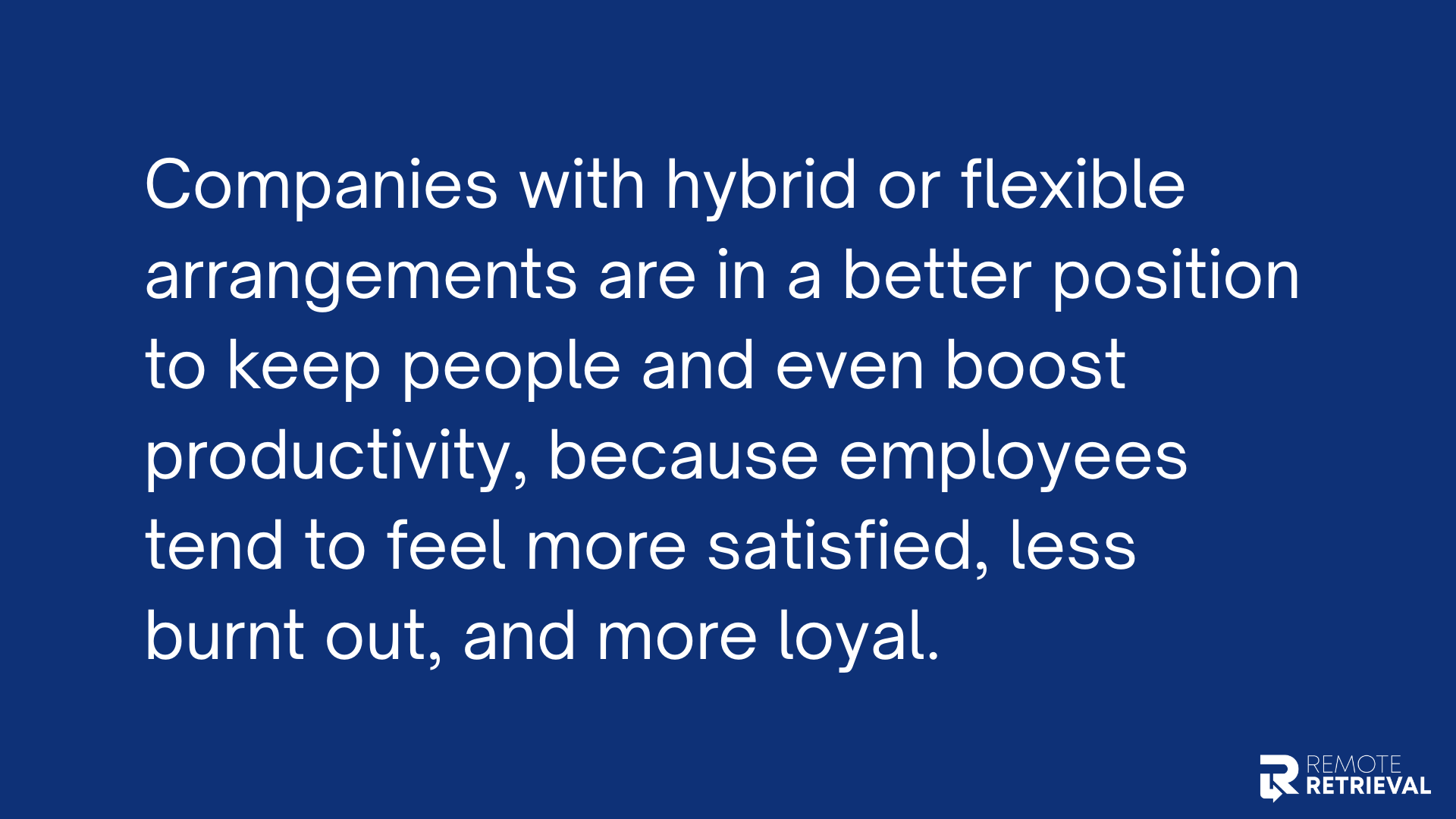
-
Retaining talent is tougher when employees feel forced into a schedule that doesn’t match their lives. Companies with hybrid or flexible arrangements are in a better position to keep people and even boost productivity, because employees tend to feel more satisfied, less burnt out, and more loyal. The Gallup data support this: when employees can work from their preferred location mix, they report better engagement, less burnout, and a lower likelihood of quitting.
Why Some Employees Welcome Structure, Others See It as Loss of Flexibility
-
For those who welcome structure, reasons include improved collaboration and face-to-face mentorship, clearer separation of work and home life, and better alignment with team goals and company culture.
-
On the flip side, loss of flexibility often means longer commutes, higher travel costs, less control over work schedules, and more difficulty balancing caregiving or home responsibilities.
-
Many employees feel RTO mandates as a rollback of gains made during the remote work period. It’s not just about physical presence—it’s about how much autonomy they’d have. Surveys show people under 50 and those who work fully remote are especially likely to see RTO mandates as restrictive.
Impact on Morale, Retention, and Recruitment
-
A Pearl Meyer survey found that about 37% of leaders say RTO policies improved employee morale and culture, while 42% believe the opposite—that RTO had a negative impact.
-
In the same survey, when asked about retention, only 12% of respondents said RTO has had a positive impact on retention; 39% were unsure.
-
Hiring is becoming harder: 62% of organizations report increased difficulty filling professional/office roles due to strict RTO expectations.
-
Another study “Navigating the Return to Office in 2025: Trends, Data & Strategies” showed that employees in a hybrid group (with two remote days per week) are 33% less likely to quit compared to those mandated to be in-office full-time; the quit rate dropped from 7.2% (full-office) to 4.8% (hybrid).
Industry-Specific Trends in RTO Policies
Different sectors are charting different paths when it comes to Return to Office (RTO) policies in 2025. What’s right for a tech company might feel impossible for a hospital. Below are key trends across industries, with real cases to show how the theory meets practice.
• Tech – Hybrid Models to Foster Innovation While Retaining Talent
Tech companies are increasingly favoring structured hybrid models—not full remote, not full office, but a mix aimed at balancing creativity with flexibility. For instance, Microsoft has announced a new RTO policy requiring most employees to work in the office at least three days a week beginning in phases around early 2026. This shift reflects data showing stronger collaboration and improved output when teams have regular in-person interaction. Offices in tech are also being reimagined—spaces are less about rows of desks and more about collaborative hubs and meeting zones.
• Finance and Law – Leaning More on Traditional Office Setups for Client-Facing Roles
Finance and legal sectors are among the leaders pushing for more in-office time, especially for client-facing roles. The Bank of New York Mellon (BNY) is moving its employees to a four-day in-office week by September 2025, up from three days. Barclays similarly increased the minimum required attendance from two to three days per week. Many roles within these sectors (investment banking, client consulting, litigation) are seeing full-week expectations or heavily weighted office presence.
• Healthcare and Education – Increased On-Site Presence for Essential Services
In healthcare and education, the need for in-person work remains strong. Clinical roles, hands-on labs, patient care, and classroom instruction make remote work less feasible. Higher education institutions are investing more in hybrid-capable infrastructure (for remote lectures, virtual labs) but still maintaining strong in-person commitments for essential services. For example, recent shifts in higher ed classroom technology show more campus-wide deployment of AV/IT systems to support both remote and on-site modalities.
• Startups and Creative Industries – Experimenting with Flexible RTO Models to Attract Younger Talent
Startups and creative companies are using RTO policy design as a competitive advantage. Flexibility is a selling point: many newcomers in these sectors expect hybrid or remote options. The creative and media industries are generally slower to force full office attendance, preferring “office days” for collaboration, client workshops, or events, balanced with remote working. Smaller firms in tech also tend to remain flexible: as surveys show, many companies under 500 employees are keeping more lenient or fully flexible work arrangements.
The Role of Technology in Supporting RTO Policies
Technology makes RTO policies realistic, flexible, and even pleasant. With the right tools, companies can ease friction, improve collaboration, and ensure office spaces are used smartly. Three technology areas that are especially impactful are as follows:
• Hybrid Collaboration Tools
Tools like Zoom, Microsoft Teams, Slack, and Miro continue to evolve, going beyond video calls to become hubs for collaboration. These tools allow seamless collaboration and transitions between in-office and remote work: whiteboard sessions, shared project boards, and synchronous as well as asynchronous communication.
For example, high-quality audio and video solutions are being rolled out to handle acoustic challenges in shared offices, making hybrid meetings more engaging. These tools help avoid issues like “who’s in the office” confusion, so teams can coordinate better on which days to meet up physically.
• AI-Driven Scheduling and Workplace Analytics
Scheduling used to be a logistical headache; now AI helps smooth it out. Tools like Clockwise and Reclaim.ai analyze calendars, identify meeting conflicts, protect “focus time,” and suggest ideal slots for team gatherings.
For example, Reclaim.ai claims to help teams reclaim hours lost to inefficient scheduling. AI workplace analytics also allow managers to see how often offices are under-utilized or overcrowded, which days see the most collaboration, and how to adjust office space and office-day mandates accordingly.
• Smart Office Technology
Modern offices are getting smarter physically as well as digitally:
Hot-desking systems let employees reserve desks on the days they come in. You can see who’s around, so you can sit near collaborators. Microsoft’s “Places” is a good example. It helps with intelligent desk and room booking, avoiding commute regret and lonely in-office days.
Wellness tracking tools help manage occupancy and air quality or ensure spaces are clean and safe—things employees care about now post-pandemic.
Digital ID access and security systems ensure that people who come to the office are authorized, limit access to shared areas, and often tie into occupancy sensors to monitor usage for safety and cost control.
Balancing Culture, Flexibility, and Business Needs
Wonder what the biggest challenge with RTO policies is? It’s not the technology or even the logistics; it’s the people side of the equation. Leaders are learning that how they frame RTO can make or break employee buy-in. Rather than treating it as a compliance checklist, many companies are redefining RTO as part of their culture strategy, which brings people together, supports well-being, and aligns with broader business goals.
• RTO as Culture-Building, Not Just Compliance
When leaders present RTO as an opportunity for employees to reconnect, share ideas, and strengthen team bonds, it feels less like a mandate and more like an investment in culture. Offices are being reimagined as spaces for collaboration, mentorship, and networking, not just cubicles. This shift in mindset helps employees see the why behind returning, which often makes the transition smoother.
• Best Practices: Flexibility, Feedback, and Well-Being
Successful organizations don’t view RTO policies as static—they’re adaptive. Best practices emerging in 2025 include:
-
Flexible scheduling: Letting teams choose which in-office days work best.
-
Feedback-driven updates: Using employee surveys and focus groups to refine policies.
-
Focus on well-being: Adding wellness perks, mental health resources, or compressed workweeks to make in-office time feel worthwhile.
These practices reduce friction and build trust by showing employees their needs are being heard.
• The Need for Empathy and Transparency
Employees can accept structure, but they resist when it feels imposed without explanation. Leaders who communicate openly—explaining the reasons for RTO, listening to concerns, and acknowledging challenges—tend to get stronger buy-in. Empathy matters too: understanding the different realities of caregivers, commuters, or younger workers helps organizations tailor policies that feel fair. Transparency and empathy together create a culture where employees may not love every policy, but they respect it because it feels balanced and honest.
The Future of RTO: Beyond 2025
Return-to-office policies aren’t going away anytime soon—but they’re also not standing still. Looking ahead, the most successful organizations will treat RTO as a living framework that evolves with employee expectations, market shifts, and technology. AI-powered workplace tools, smarter offices, and hybrid scheduling will continue to make RTO smoother, but culture will remain the heart of it.
We’re also likely to see more personalization: policies tailored by role, department, or even individual preference. Instead of “one-size-fits-all,” RTO could become “fit-for-purpose.” Industries like tech and creative sectors may lean into flexibility to win talent, while finance, law, and healthcare will likely stick to stronger on-site requirements. The middle ground—structured hybrid—may become the dominant model globally.
